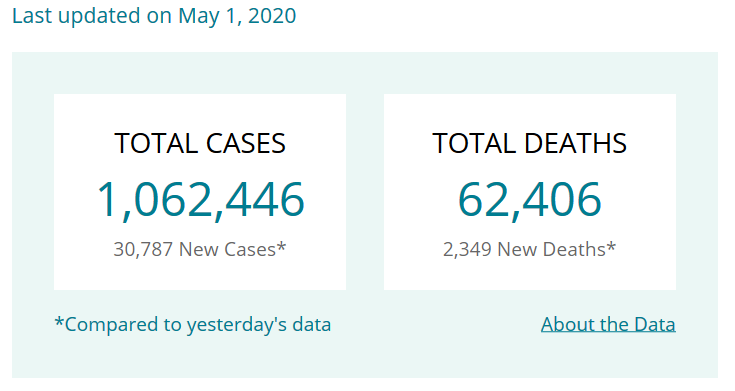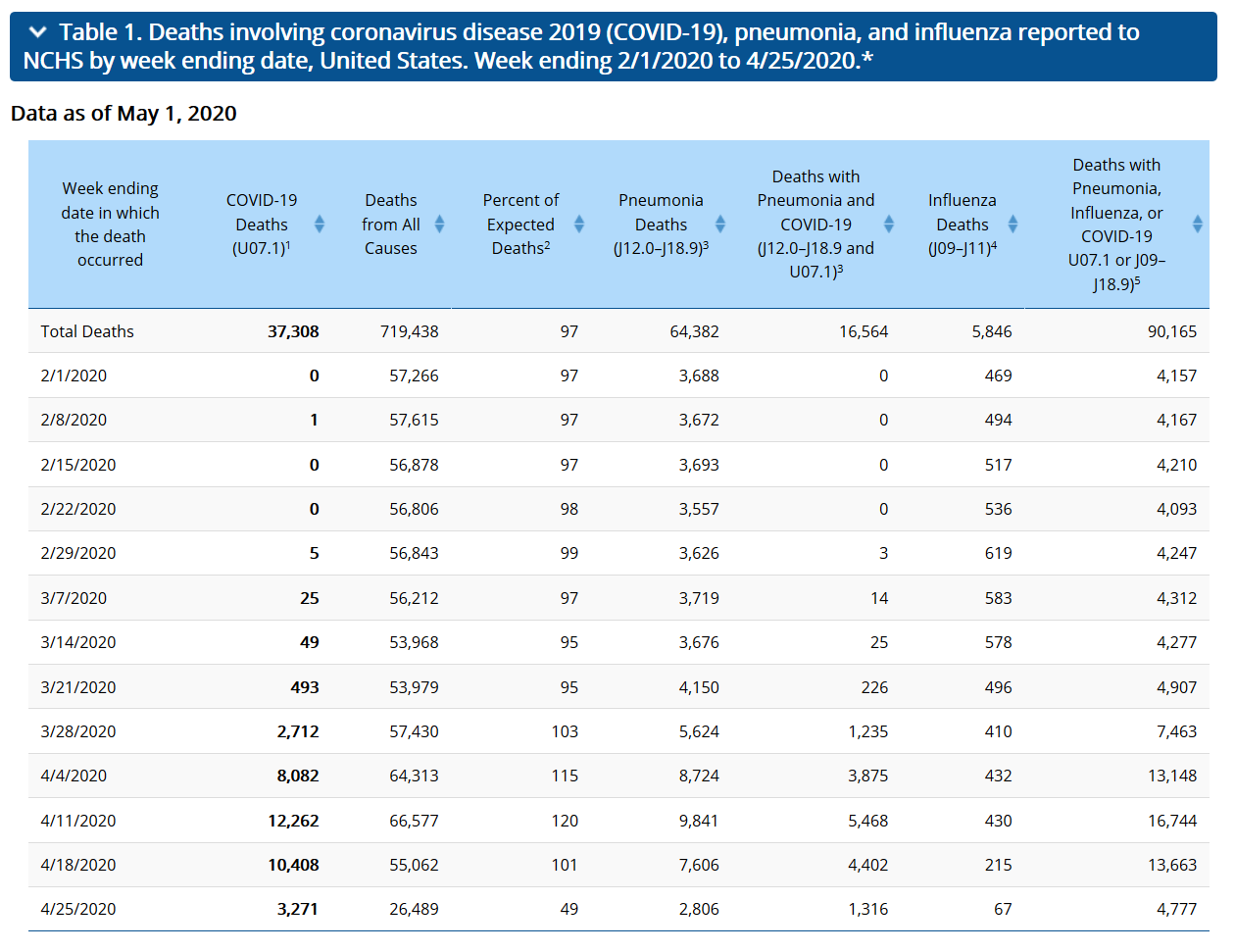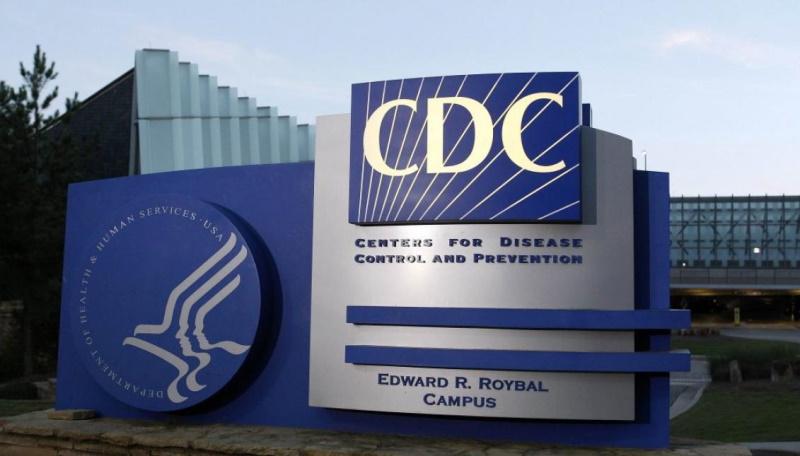As of May 1st, 2020, the CDC has revised their statistics for the number of people who have died in the US from Covid-19 caused by the SARS-CoV-2 virus.
Many media outlets are for some reason overstating the number of deaths attributed to Covid-19, with several quoting numbers over 65,000 as of May 1st. The website Worldometer.info, which is often cited for their statistics, had recorded 67,444 deaths from the virus on the same date, which could be the justification for the reported numbers.

On the CDC website they had reported 62,406 deaths as of May 1st. The CDC explains that the numbers posted include confirmed and suspected cases as submitted to them on a State by State basis. Each State has a varying schedule for submitting their data to the CDC, so this could help explain the discrepancy of 5,000 deaths listed.
However on the same website the CDC posted Provisional Death Counts for Coronavirus Disease (COVID-19) with only 37,308 deaths attributed to SARS-CoV-2 on May 1st. They also recorded 64,382 deaths from pneumonia, 16,564 deaths from Covid-19 and pneumonia, and 5,846 deaths from influenza or the flu, for the same time period.

If we combine the deaths from Covid-19 to the statistics of those deaths attributed to Covid-19 and pneumonia, we get a total number of deaths of 53,872 still well below the 62,406 statistic posted elsewhere on the CDC website.
While adding to the confusion regarding the statistics, it is important to note that the provisional statistics are based on confirmed mortalities reported from each State and there can be a lag time of up to several weeks for the CDC to receive the confirmed number of deaths.
This would imply that the CDC would receive a minimum of 10,000 new confirmed deaths over the next several weeks; deaths recorded before May 1st. Based on the statisitics posted this seems unlikely, considering that most States are reporting fewer cases as of the 25th of April, however it is possible some states could have higher than expected numbers. It is simply too early to say.
There are two important points that need to be noted.
The first being that the number of deaths directly attributed to Covid-19 is drastically lower than the numbers reported in the media. While we can all agree it is better to be safe than sorry, that does not justify overstating the number of deaths by over 25,000.There is no logical justification for this from any media outlet claiming to be presenting facts to the public.
It is also irresponsible to conflate the number of people dying from this awful virus with those dying from other causes, without clarifying the circumstances. If someone died due to complications from the virus, it should be noted. If someone dies from cardiovascular problems or other medical issues and also tested positive for Covid-19, it should not be immediately assumed the person died as a result of having the virus. The virus can be a contributing factor without being the cause. There is a distinction.
The second matter of note and one that has received little more than a footnote in the news, is the number of people who have succumbed to pneumonia during the same time frame exceeds the number of deaths from Covid-19. By the CDC's stastistics for the period up to May 1st, the number of deaths from Covid-19 are less than 58% of the numbers who died from pneumonia.
According to Global Health Now, a not-for-profit initiative of the Johns Hopkins Bloomberg School of Public Health, "pneumonia—curable and highly preventable—kills a child every 39 seconds"
- Pneumonia accounts for 15% of all deaths of children under 5 years old, killing 808,694 children in 2017 and 2.56 million people died from pneumonia in 2017
- Pneumonia can be caused by viruses, bacteria, or fungi.
- Pneumonia can be prevented by immunization, adequate nutrition, and by addressing environmental factors.
- Pneumonia caused by bacteria can be treated with antibiotics, but only one third of children with pneumonia receive the antibiotics they need.
The numbers of people who die as a result of pneumonia are repeated year after year. Over 2.5 million worldwide. It is the leading cause of death for children and seniors.
Pneumonia is caused by a number of infectious agents, including viruses, bacteria and fungi. The most common are:
- Streptococcus pneumoniae – the most common cause of bacterial pneumonia in children;
- Haemophilus influenzae type b (Hib) – the second most common cause of bacterial pneumonia;
- respiratory syncytial virus is the most common viral cause of pneumonia;
- in infants infected with HIV, Pneumocystis jiroveci is one of the most common causes of pneumonia, responsible for at least one quarter of all pneumonia deaths in HIV-infected infants.
Influenza is also one of the contributors to these staggering numbers. Seasonal influenza is an acute viral infection that spreads easily from person to person and circulates worldwide. Most people recover within a week without requiring medical attention. It is responsible for over 650,000 deaths every year.
To put this in persepctive, at the time of writing this article global deaths from Covid-19 from the Worldometer website was approaching 250,000.... worldwide.
It is agreed that while the SARS-CoV-2 corona virus causing Covid-19 is resulting in increased hospitalizations and an increased risk of death for many who are exposed, it is unclear as to whether this should have reached the level of being labeled a pandemic.
There will be ample time to debate whether the measures taken to reduce the spread of the disease on a global scale were warranted, considering the economic fallout we have yet to fully contemplate. It should be noted that mortality estimates at the outset indicated this could be a global catastrophe. Initial estimates for the US stated that Covid-19 could kill anywhere from 200,000 to 1.7 million people. With social distancing they believed they could reduce that by half. Still a staggering number.
While it is now apparent that we are nowhere close to the original estimates, and that the original estimates have been drastically reduced several times, it is high time that we begin to ease back into allowing business and famililies to return to normal life. Alternatively we need to consider keeping social distancing and stay at home measures until we also eliminate pneumonia, malaria and other communicable diseases that pose a greater risk to the health and well being of our friends and family.
In any case, it is not time to behave like it never happened.
Each community needs to assess the situation and gradually ease up restrictions. Clearly what works in a community of a few thousand may not be recommended for a city of one million or more.
The national governments have a duty to allow communities to take a more active role in governing and continue monitor the situation, rather than dictating a one size fits all solution. The provincial or state governments, can aid in monitoring the situation regionally and aid in providing solutions for communities who may not have the resources to manage the recovery.
The key is for the members of each community to take some responsibility and maintain a common sense approach to returning to regular activities. We can open the beaches, and allow locals to walk, jog, bike, swim, surf and fish, provided they avoid congregating in groups. We can allow churches to open, provided they reduce the number of people attending at any one time, perhaps by scheduling several sermons, or holding them in open air settings rather than within the confines of a building.
The sooner we can all demonstrate some responsibility, the sooner we can achieve a return to what most of us consider a normal life.










